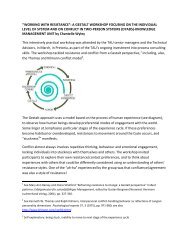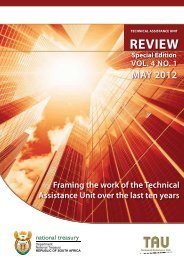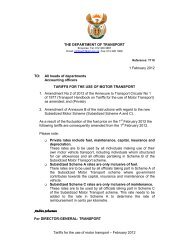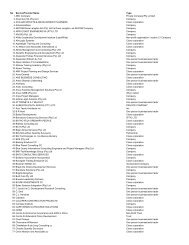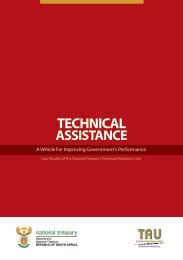Review 3 final 2 - TAU - National Treasury
Review 3 final 2 - TAU - National Treasury
Review 3 final 2 - TAU - National Treasury
Create successful ePaper yourself
Turn your PDF publications into a flip-book with our unique Google optimized e-Paper software.
TECHNICAL ASSISTANCE UNIT REVIEW | SIMULTANEOUS MAINSTREAMING OF GENDER AND DISABILITY<br />
Coordination and accountability<br />
As well as having targets for gender and disability<br />
clearly articulated, there is a need for those goals to<br />
be consistent and co-ordinated. Once a set of goals is<br />
established, there is a need to find ways of achieving<br />
those targets and steering the organisation to attain<br />
those goals.<br />
Accountability from a gender perspective requires<br />
that the decisions of public actors can be assessed<br />
by women and men equally. Gender-sensitive<br />
accountability systems require not just women’s<br />
participation, but also institutional reform to make<br />
gender equality one of the standards against which<br />
the performance of decision-makers is assessed. 12<br />
Leadership<br />
Good governance in respect of gender and disability<br />
mainstreaming calls for effective leadership that rises<br />
to the challenges of gender and disability equality.<br />
Such leadership is characterised by the ethical<br />
values of responsibility, accountability, fairness and<br />
transparency and based on moral duties that find<br />
expression in the concept of Ubuntu. 13 Responsible<br />
leaders direct workplace strategies and operations<br />
with a view to eradicate discrimination based on<br />
gender and disability, and to promote, protect and<br />
attain the human rights of women and persons with<br />
disabilities, achieving sustainable economic, social and<br />
environmental performance.<br />
Endnotes<br />
1 Schalkwyk, J., Thomas, H. & B Woroniuk. 1996. Mainstreaming: A<br />
Strategy for Achieving Equality between Women and Men: A Think<br />
Piece. Stockholm: SIDA.<br />
2 Riley, J, 2004. “Some reflections on gender mainstreaming and<br />
intersectionality”, Development Bulletin, 64: Pg 82-86.<br />
3 Booth, C. & Bennett, C. 2002. “Gender Mainstreaming in the<br />
European Union“. European Journal of Women’s Studies, 9 (4): Pg<br />
430-446.<br />
4 Jahan, R. 1995. The Elusive Agenda: Mainstreaming Women in<br />
Development, Zed Books, London.<br />
5 Beveridge, F. & Nott, S. 2002. “Mainstreaming: A case for optimism<br />
and cynicism”, Feminist Legal Studies, 10: Pg 299–311.<br />
6 ECOSOC 1997. Agreed Conclusions on Mainstreaming the Gender<br />
Perspective into all Policies and Programs in the United Nations<br />
System, United Nations.<br />
7 Office on the Status of Women. South Africa’s <strong>National</strong> Policy<br />
Framework for Women’s Empowerment and Gender Equality.<br />
8 Walby, s. “Gender Mainstreaming: Productive Tensions in Theory<br />
and Practice”, Social Politics, Fall 2005: Pg 321-343.<br />
9 Pollack, M.A. & Hafner-Burton, E. 2000. “Mainstreaming Gender in<br />
the European Union”. Journal of European Public Policy, 7 (3): Pg<br />
432-56.<br />
10 Riley, J. 2004. “Some reflections on gender mainstreaming and<br />
intersectionality”, Development Bulletin, 64: Pg 82-86.<br />
11 King III, 2009.<br />
12 UNIFEM. Progress of the World’s Women 2008/2009.<br />
13 Based on notes from the King Report on Governance for South<br />
Africa, Institute of Directors, 2009. Practice Notes. Pg 9.<br />
Maretha de Waal<br />
Development Consultant<br />
page 33<br />
Enabling change for development



